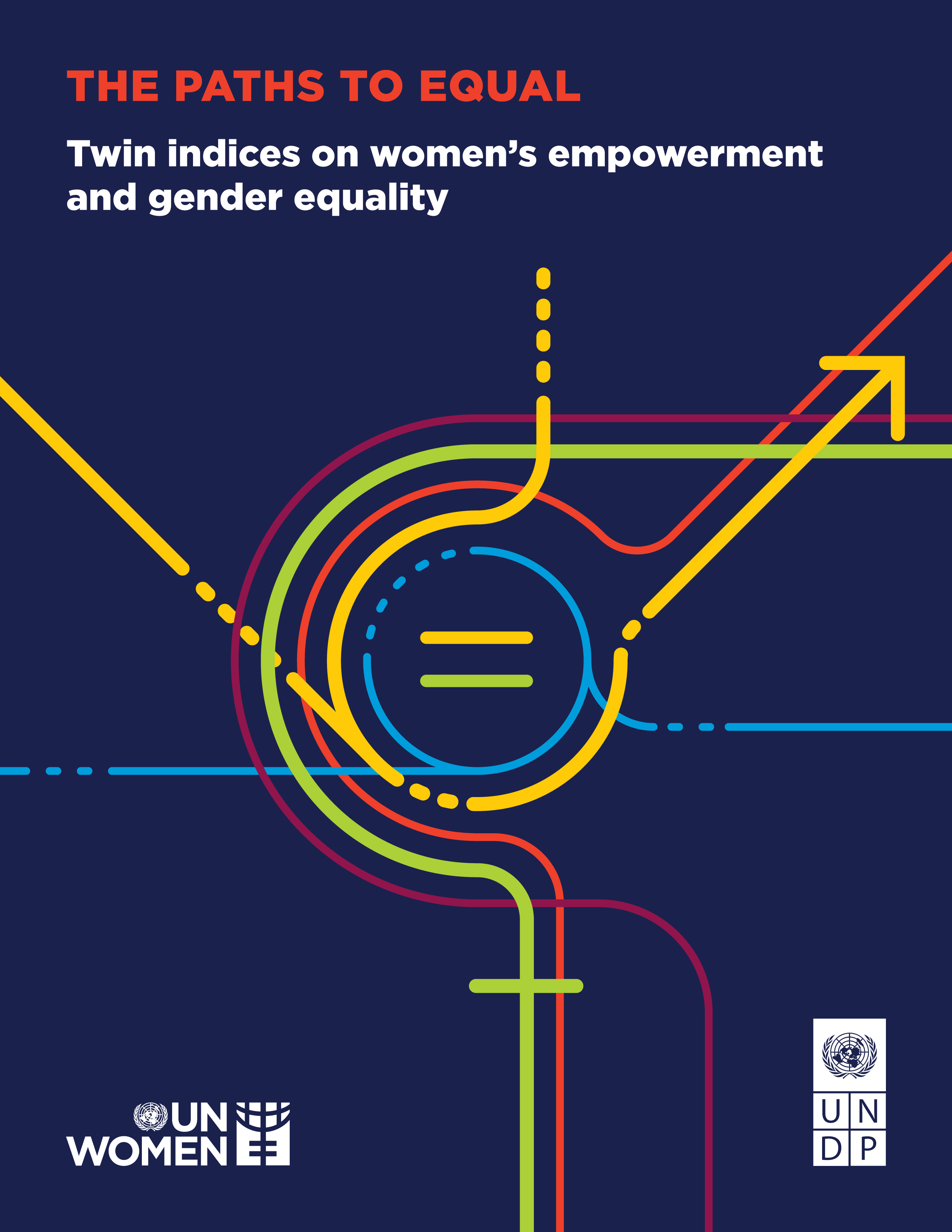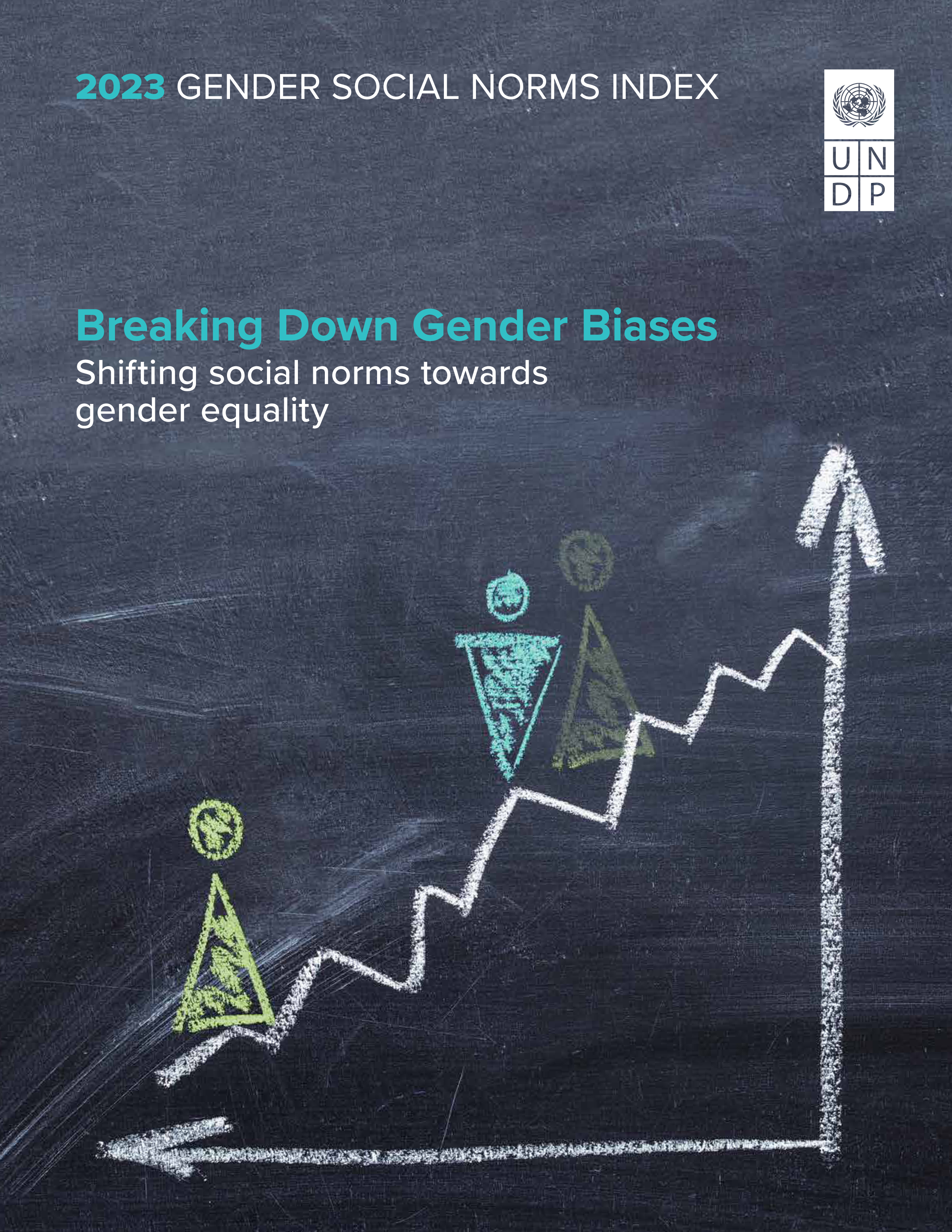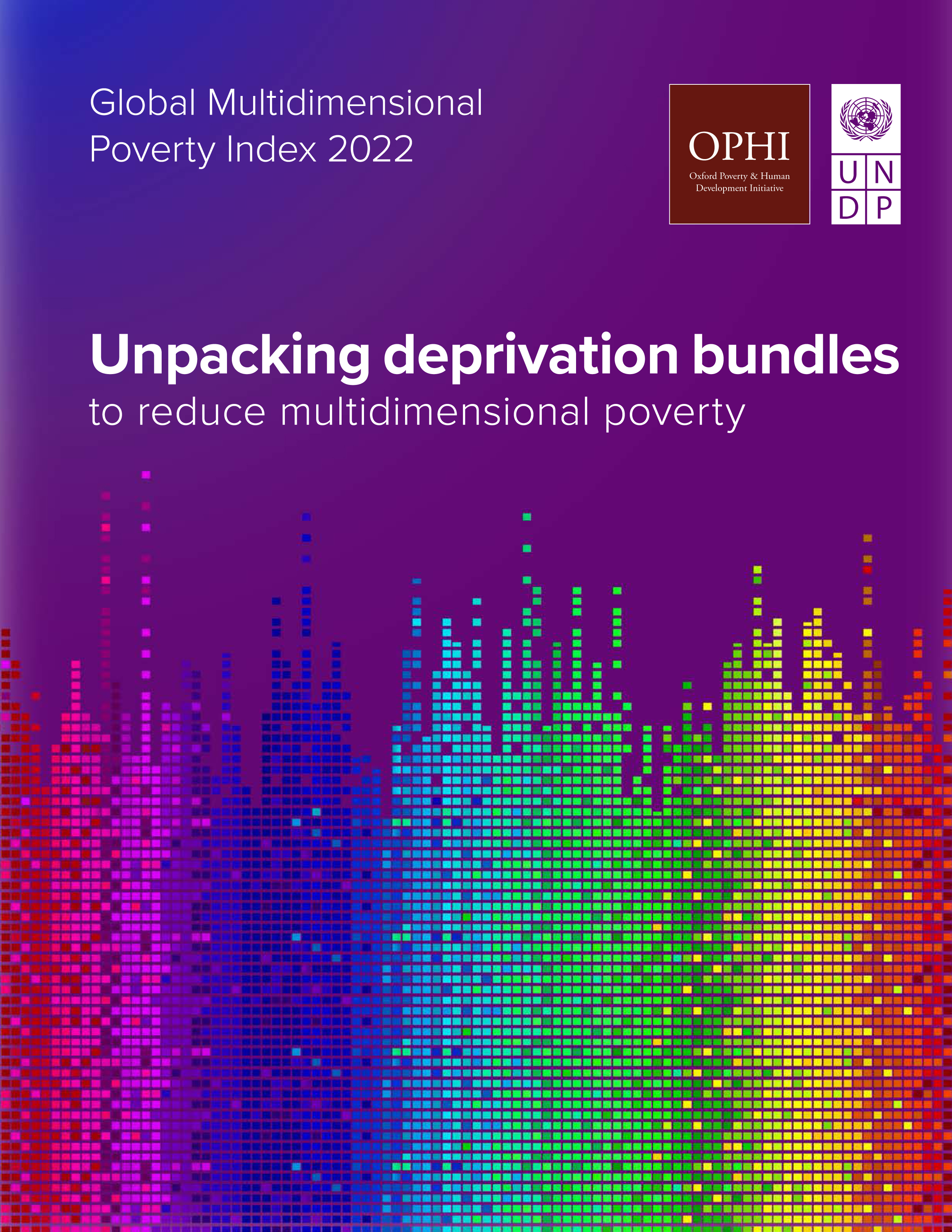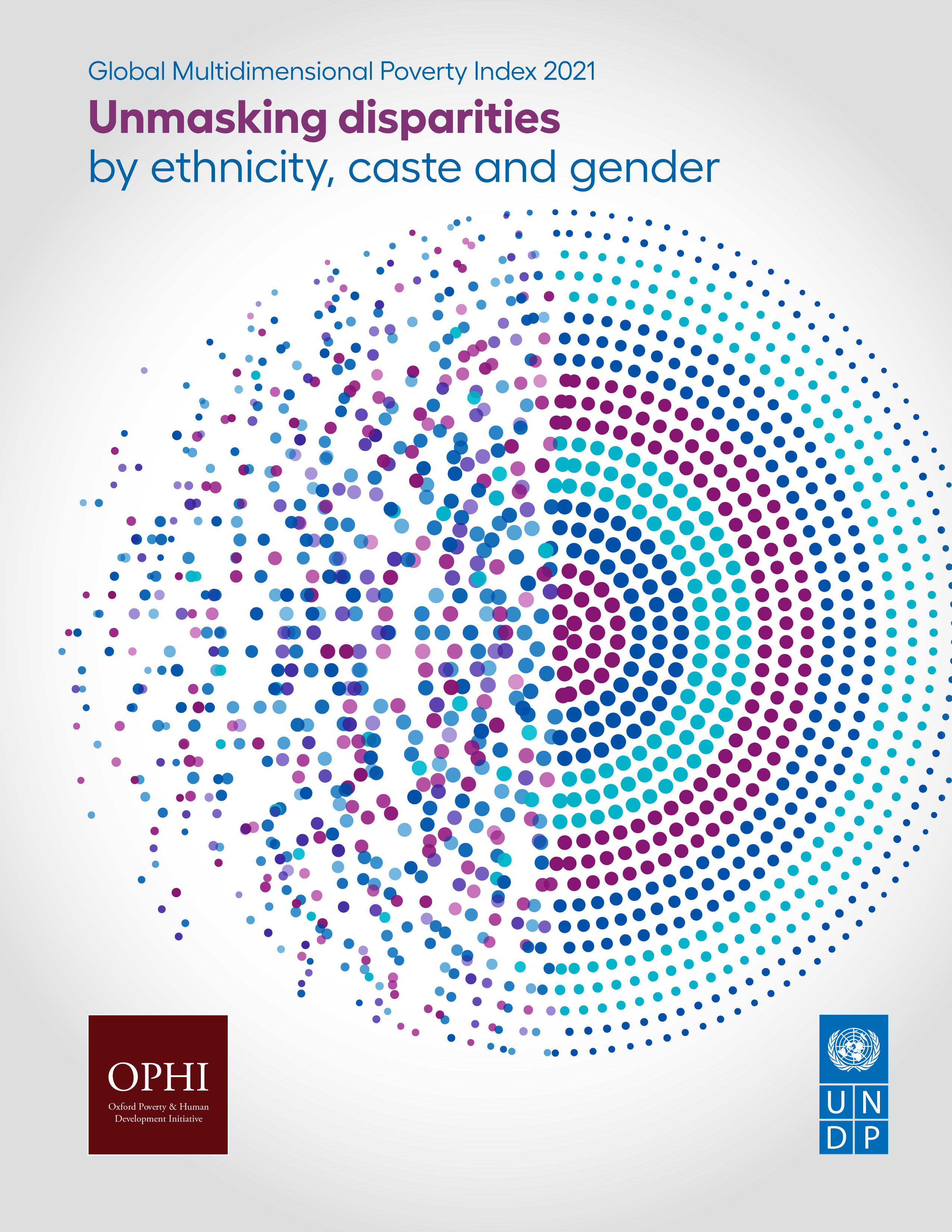Human Development Perspectives
Human Development Perspective series was introduced by the UNDP's Human Development Report Office in 2020 as a flexible platform for extending the research from the annual global Human Development Report, and to cover the emerging issues facing human development year-round.

Global Multidimensional Poverty Index 2025
Overlapping Hardships: Poverty and Climate Hazards
This 2025 Global Multidimensional Poverty Index (MPI) report, for the first time, overlays data on climate hazards and multidimensional poverty to assess how exposed poor people are to environmental shocks. The report highlights that most people in poverty are exposed to at least one climate hazard; many confront several at the same time. By the end of this century, the countries projected to face the steepest temperature increases are those already burdened with higher levels of multidimensional poverty. This year’s update of the global MPI database includes new data from 13 countries. It presents MPI data from 109 countries, along with subnational estimates covering 1,359 regions across 101 countries. The results show that 1.1 billion of 6.3 billion people live in acute multidimensional poverty, over half of them children. Common deprivations include a lack of clean cooking fuel, housing, sanitation, nutrition, and electricity. The intertwining of climate and poverty risks is likely to intensify in the future, and the report makes a compelling case for addressing a double burden that may only worsen.

Global Multidimensional Poverty Index 2024
Poverty Amid Conflict
This 2024 Global Multidimensional Poverty Index (MPI) report overlays violent conflict data with multidimensional poverty data to better understand their interlinkages across countries and over time. The Uppsala Conflict Data Program (UCDP) is the primary data source, but sensitivity analyses were also run using other key conflict datasets. The report finds that MPI values tend to be much higher in conflict-affected settings. And in countries affected by protracted conflict, poverty reduction is reversed, stagnant or slower. This year’s update of the global MPI database includes new data from 20 countries. It presents MPI data from 112 countries covering 1,359 subnational regions. The results show that 1.1 billion of 6.3 billion people live in acute multidimensional poverty, over half of them children. Common deprivations include a lack of adequate housing, sanitation, electricity, cooking fuel, nutrition and school attendance. Reaching the last mile to eliminate global poverty requires careful attention to people living in contexts of violent conflict.

Unstacking Global Poverty: Data for High-impact Action
Global Multidimensional Poverty Index 2023
This report presents a compact update on the state of multidimensional poverty (henceforth referred to as “poverty”) in the world. It compiles data from 110 developing countries covering 6.1 billion people, accounting for 92 percent of the population in developing countries. It tells an important and persistent story about how prevalent poverty is in the world and provides insights into the lives of poor people, their deprivations and how intense their poverty is—to inform and accelerate efforts to end poverty in all its forms. As still only a few countries have data from after the COVID-19 pandemic, the report urgently calls for updated multidimensional poverty data. And while providing a sobering annual stock take of global poverty, the report also highlights examples of success in every region.

The Paths to Equal: New Twin Indices on Women’s Empowerment and Gender Equality
This report centres on the unfinished business of our time: delivering on the promise of gender equality, securing the human rights of women and girls and ensuring that their fundamental freedoms are fully realized. To address the empowerment of all women and girls and gender equality, the human development approach, rooted in capabilities, provides a conceptual framework. It pivots on enlarging opportunities for all people, equally. As progress towards gender equality stalls, the United Nations Entity for Gender Equality and the Empowerment of Women (UN Women) and the United Nations Development Programme (UNDP) have joined forces to expand measures that guide national and international policy action, research and advocacy on the empowerment of all women and girls and gender equality. The result of this collaboration is the twin experimental gender indices in this report. The first, the new Women’s Empowerment Index, focuses on measuring women’s power and freedoms to make choices and seize opportunities in life. It is the first UN gender index to include violence against women and girls as a standalone dimension. The second, the Global Gender Parity Index, assesses the gender gap across four dimensions of human development: health, education, inclusion and decisionmaking. Together, they provide a more complete picture of countries’ progress towards women’s empowerment and gender equality. These indices are a key contribution to the Sustainable Development Goals (SDGs) stock-taking moment at the 2023 SDG Summit and a means of furthering efforts to achieve SDG 5 on gender equality.

Breaking Down Gender Biases: Shifting Social Norms Towards Gender Equality
2023 Gender Social Norms Index
Without tackling biased gender social norms, we will not achieve gender equality or the Sustainable Development Goals. Biased gender social norms—the undervaluation of women’s capabilities and rights in society—constrain women’s choices and opportunities by regulating behaviour and setting the boundaries of what women are expected to do and be. Biased gender social norms are a major impediment to achieving gender equality and empowering all women and girls. Gender bias is a pervasive problem worldwide. The Gender Social Norms Index (GSNI) quantifies biases against women, capturing people’s attitudes on women’s roles along four key dimensions: political, educational, economic and physical integrity. The index, covering 85 percent of the global population, reveals that close to 9 out of 10 men and women hold fundamental biases against women. Nearly half the world’s people believe that men make better political leaders than women do, and two of five people believe that men make better business executives than women do. Gender biases are pronounced in both low and high Human Development Index (HDI) countries. These biases hold across regions, income, level of development and cultures—making them a global issue.

Unpacking Deprivation Bundles to Reduce Multidimensional Poverty
Global Multidimensional Poverty Index 2022
The 2022 MPI Report finds that reducing poverty at scale is possible and unveils new 'poverty profiles' that can offer a breakthrough in development efforts to tackle the interlinked aspects of poverty. The report identifies a series of 'deprivation bundles' -- recurring patterns of poverty -- that commonly impact those who live in multidimensional poverty across the world. The data are used to identify the poverty profiles that are more common in certain places. This is a crucial step in designing strategies that address multiple aspects of poverty at the same time. Even before the COVID-19 pandemic and the current cost-of-living crisis are accounted for, the data shows that 1.2 billion people in 111 developing countries live in acute multidimensional poverty. This is nearly double the number who are seen as poor when poverty is defined as living on less than $1.90 per day.

New Threats to Human Security in the Anthropocene
Demanding Greater Solidarity
New data and analysis in the report, New Threats to Human Security in the Anthropocene, shows that people’s sense of safety and security is at a low in almost every country, including the richest countries, despite years of upwards development success. Those benefiting from some of the highest levels of good health, wealth, and education outcomes are reporting even greater anxiety than 10 years ago. To tackle this disconnect between development and perceived security, the report calls for greater solidarity across borders and a new approach to development; one that allows people to live free from want, fear, anxiety and indignity. The imperative to act now has never been more clear, as new findings also show that global life expectancy at birth is falling for a second year because of COVID-19, and overall human development measures are also moving downward. Furthermore, climate change is likely to become a leading cause of death around the world. Even with moderate mitigation of emissions, some 40 million people might die because of changes in temperatures before the end of the century. The report examines a cluster of threats that have shifted to become more prominent in recent years including those from digital technologies, inequalities, conflicts, and the ability of healthcare systems to tackle new challenges like the COVID-19 pandemic. Addressing these threats will require policy makers to consider protection, empowerment, and solidarity alongside one another so that human security, planetary considerations and human development all work together and not despite each other. This means that solutions for one problem shouldn’t exacerbate other problems. The report also notes the strong association between declining levels of trust and feelings of insecurity. People with higher levels of perceived human insecurity are three times less likely to find others trustworthy.

Unmasking Disparities by Ethnicity, Caste and Gender
Global Multidimensional Poverty Index 2021
This report provides a comprehensive picture of acute multidimensional poverty to inform the work of countries and communities building a more just future for the global poor. It examines the levels and composition of multidimensional poverty across 109 countries covering 5.9 billion people. It also discusses trends among more than 5 billion people in 80 countries, 70 of which showed a statistically significant reduction in Multidimensional Poverty Index value during at least one of the time periods presented. While the COVID-19 pandemic’s impact on developed countries is already an active area of research, this report offers a multidimensional poverty perspective on the experience of developing countries. It explores how the pandemic has affected three key development indicators (social protection, livelihoods and school attendance), in association with multidimensional poverty, with a focus predominantly on Sub-Saharan Africa. It profiles disparities in multidimensional poverty with new research that scrutinizes estimates disaggregated by ethnicity or race and by caste to identify who and how people are being left behind. It also explores the proportion of multidimensionally poor people who live in a household in which no female member has completed at least six years of schooling and presents disparities in multidimensional poverty by gender of the household head.

COVID-19 and Human Development
Assessing the Crisis, Envisioning the Recovery
The COVID-19 (coronavirus) pandemic is unleashing a human development crisis. On some dimensions of human development, conditions today are equivalent to levels of deprivation last seen in the mid-1980s. But the crisis is hitting hard on all of human development’s constitutive elements: income (with the largest contraction in economic activity since the Great Depression), health (directly causing a death toll over 300,000 and indirectly leading potentially to an additional 6,000 child deaths every day from preventable causes over the next 6 months) and education (with effective out-of-school rates – meaning, accounting for the inability to access the internet – in primary education expected to drop to the levels of actual rates of the mid-1980s levels). This, not counting less visible indirect effects, including increased domestic violence, yet to be fully documented. The pandemic was superimposed on unresolved tensions between people and technology, between people and the planet, between the haves and the have-nots. These tensions were already shaping a new generation of inequalities— pertaining to enhanced capabilities, the new necessities of the 21st century, as defined in the 2019 Human Development Report. But the response to the crisis can shape how those tensions are addressed and whether inequalities in human development are reduced. This note takes a capabilities approach to document the severity of the unfolding human development crisis. Such an approach implies an evaluative framework to assess the crisis and shape the policy response that emphasizes the potential for people to be and do what they aspire in life as opposed to material resources or economic activity. To assess the crisis, the note draws from original simulations that are based on an adjusted Human Development Index— with the education dimension modified to reflect the effects of school closures and mitigation measures—and that incorporate current projections of gross national income (GNI) per capita for 2020.

Tackling Social Norms
A game Changer for Gender Inequalities
Gender disparities are a persistent form of inequality in every country. Despite remarkable progress in some areas, no country in the world—rich or poor—has achieved gender equality. All too often, women and girls are discriminated against in health, in education, at home and in the labour market—with negative repercussions for their freedoms. This is the time for a reality check. The commemoration of the 25th anniversary of the adoption of the Beijing Declaration and Platform for Action (Beijing+25) provides an opportunity to reassess the path to gender equality and adjust actions to close gender gaps. The Gender Social Norms Index (GSNI) measures how social beliefs obstruct gender equality in areas like politics, work, and education, and contains data from 75 countries, covering over 80 percent of the world’s population. According to the index, about half of the world’s men and women feel that men make better political leaders, and over 40 percent feel that men make better business executives and that men have more right to a job when jobs are scarce. 28 percent think it is justified for a man to beat his wife. The publication also includes the GSNI trends for 31 countries, representing 59 percent of the global population. The trends show that while in some countries there have been improvements, in others, attitudes appear to have worsened in recent years, signaling that progress cannot be taken for granted.

Charting Pathways Out of Multidimensional Poverty: Achieving the SDGs
This report focuses on how multidimensional poverty has declined. It provides a comprehensive picture of global trends in multidimensional poverty, covering 5 billion people. It probes patterns between and within countries and by indicator, showcasing different ways of making progress. Together with data on the $1.90 a day poverty rate, the trends monitor global poverty in different forms. This is a key moment to study how nonmonetary poverty goes down. It is 10 years before 2030, the due date of the Sustainable Development Goals (SDGs), whose first goal is to end poverty in all its forms everywhere. And it is a year when a pandemic and economic slowdown are pushing many more into poverty, while the spectre of racism still haunts, and environmental threats such as locusts surge. Multidimensional poverty is strongly associated with other SDG challenges. Concentrated in rural areas, multidimensionally poor people tend to experience lower vaccination rates and secondary school achievement, insecure work and greater environmental threats. By detailing the connections between the MPI and other poverty-related SDGs, the report highlights how the lives of multidimensionally poor people are precarious in ways that extend beyond the MPI’s 10 component indicators. The COVID-19 pandemic unfolded in the midst of this analysis. While data are not yet available to measure the rise of global poverty after the pandemic, simulations based on different scenarios suggest that, if unaddressed, progress across 70 developing countries could be set back 3–10 years.
